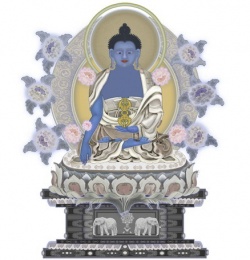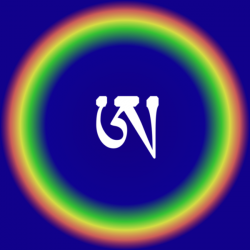Rigpa
In a Dzogchen context, rigpa (Skt. vidyā; Tibetan: རིག་པ་, Wylie: rig pa) is the knowledge that ensues from recognizing one's nature. At the trekchö level, one knows that there is a primordial freedom from grasping his or her mind (sems). The opposite of rigpa (vidyā, knowledge) is marigpa (avidyā, ignorance).
- A Dzogchen Master STARTS with "direct introduction" with everyone. If they don't "get it" then one starts to use all the infinite methods and means to help bring about the experience of Rigpa. When one has the experience of Rigpa, then one confirms the validity of one's path now being "remaining with Rigpa" as path. Then, one simply continues in that state. Rigpa is the view to be experienced, Rigpa is the path to be followed, and Rigpa is the fruit of the path. There is no change in Rigpa, either in the beginning, middle or end. The fruit is your first realization of Rigpa. There are no Stages of Rigpa. Thogel does not modify Rigpa.
- ——Dudjom Rinpoche on the Three Statements of Garab Dorje
Apperception and beyond
Rigpa has three wisdoms, two of which are kadag and lhun grub. Kadag (primordial purity) is the Dzogchen view of emptiness. Lhun grub (natural formation) is the Dzogchen view of dependent origination. Throughout Mahayana, emptiness and dependent origination are two sides of the same coin. Kadag deals with tregchöd. The lhun grub aspect has to do with esoteric practices, such as (but not limited to) Thödgal, that self-liberate the dependently originated human body into the Sambhogakāya (rainbow body phenomenon). The symbol of Dzogchen is a Tibetan A wrapped in a thigle. The A represents kadag while the thigle represents lhun grub. The third wisdom, thugs rje (compassion), is the inseparability of the previous two wisdoms.In Dzogchen, a fundamental point of practice is to distinguish rigpa from sems (mind). The distinguishing of rigpa and sems from each other is emphasized by Jigme Lingpa and goes back to the seventeen tantras.
In the above quotation in the Tibetan nomenclature of the 'mind stream' or 'continuum' (Wylie: rgyud), 'nondual awareness' is 'Rigpa' (Wylie: rig pa) and 'self-awareness' (Wylie: rang rig) is 'Rangrig'. Rigpa is a contraction of "rang rig pa" which includes both rig pa and rang rig (Wylie: rang rig). The latter term renders the Sanskrit svasaṃvedana/svasaṃvitti, and has different senses in different vehicles. In Dharmakīrti's work it refers to the awareness (of) dualistic consciousness at the root of reflexive consciousness, which Elias Capriles explains in redefined Sartrean terminology as nondual awareness (of) consciousness of object, where the preposition "of" is within parentheses in order to indicate that there is no relation of knowledge (i.e., no dualistic, conceptual apprehension) between that nondual awareness and the dualistic consciousness of object—their relationship being like the one that obtains between a mirror and an image reflected in it. In this sense svasaṃvedana/svasaṃvitti involves reflectivity and corresponds to Kant's 'apperception' or "awareness that consciousness is perceiving"
In the Dzogchen teachings it refers to the dissolution of the dualistic consciousness in nondual awareness, so that this nondual awareness, rather than manifesting as nondual awareness (of) dualistic consciousness of object, reveals its true condition in a nondual, nonconceptual way (and therefore in this case it is not permissible to speak either of reflexivity or of apperception, for there is no dualistic, conceptual perception [of] which nondual awareness may be aware). Some have claimed that these differences are cosmetic and that they are resolved in the practice of 'meditative trance' (Wylie: 'jog pa). However, there is a radical difference between nondual awareness (of) the dualistic consciousness that is the core of saṃsāra and the nondual awareness in question fully revealing its own nature in nirvāṇa (the former involving reflexivity [which implies the subject-object duality and apperception, the second being nondually aware [of] itself and [of] its true condition). At any rate, doubts in this regard can only be resolved in the direct realization of Dzogchen, Mahamudra and so on, and in the associated literatures of the deep contemplative traditions of Himalayan Buddhism (Tibetan Buddhism, Nepalese Buddhism, Bhutanese Buddhism, etc.) and Bon, particularly Dzogchen and Mahamudra; e.g. Dark retreat (Tibetan: mun mtshams).
Pettit (1999: p. 129) holds that rangrig (Wylie: rang rig), which he renders as 'apperception,' is key to Mipham's (1846–1912) system of epistemology and hermeneutics as discussed in the DRG and in Mipham's Commentary to the Ninth Chapter of the Bodhisattvacaryāvatāra. However, in Padmasambhava, Karma Lingpa, Gyurme Dorje, Graham Coleman and Thupten Jinpa (2005: p. 480), we find the following clarification of the difference between the sense of the Tibetan rangrig and the Sanskrit 'svasaṃvitti' or 'svasaṃvedana' in Indian Buddhist epistemology and in particular in the writings of the lauded logicians Dignāga and Dharmakīrti, and their meaning in the Dzogchen teachings—in which the translators render the term by the English expression 'intrinsic awareness' :
- ...term svasaṃvedana refers to the apperceptive or reflexive faculty of consciousness, for which reason it is sometimes rendered as 'reflexive awareness' or 'apperceptive awareness'. However, in the view of the Great Perfection (rdzog-pa chen-po) and in the context of the present work [The Tibetan Book of the Dead, the same term refers to the fundamental innate mind in its natural state of spontaneity and purity, beyond the alternating states of motion and rest and the subject-object dichotomy. It is therefore rendered here as 'intrinsic awareness'. As such, intrinsic awareness gives the meditator access to pristine cognition ye-shes; jñāna or the buddha-mind thugs, citta itself, and it stands in direct contrast to fundamental ignorance (ma-rig-pa, avidyā), which is the primary cause of rebirth in cyclic existence ('khor-ba; samsara). The direct introduction to llintrinsic awareness is a distinctive teaching within the Nyingma school.... This practice is a central component of the Esoteric Instruction Class (man-ngag-gi sde, upadeśa varga) of Atiyoga, where it is known as Cutting Through Resistance (Khregs-chod).
In the language of Zhangzhung, 'rang rig' (Wylie) is 'nges de shin' where 'shin' equates to 'shes pa'. The Zhangzhung lexical item 'shin' is found in many compounds (Martin, 2004: p. 158) where it contributes a meaning of 'to know' and 'knowledge' to both nominal and verbal/process oriented lexical items.
Rigpa aims to present the Buddhist tradition of Tibet in a way that is both completely authentic, and as relevant as possible to the lives and needs of modern men and women.
Open to all schools and traditions of Buddhist wisdom, and with the guidance and gracious patronage of His Holiness the Dalai Lama, Rigpa offers those following the Buddhist teachings a complete path of study and practice, along with the environment they need to experience the teachings fully.
At the same time, Rigpa seeks to explore how the wisdom and compassion of the Buddha’s teachings can benefit many different areas of life in today’s world.
“Rigpa is a Tibetan word, which in general means ‘intelligence’ or ‘awareness’. In Dzogchen, however, the highest teachings in the Buddhist tradition of Tibet, rigpa has a deeper connotation, ‘the innermost nature of the mind’. The whole of the teaching of Buddha is directed towards realizing this, our ultimate nature, the state of omniscience or enlightenment – a truth so universal, so primordial that it goes beyond all limits, and beyond even religion itself."
Inspired by the meaning of the word rigpa, Sogyal Rinpoche gave this as the name for his work and to the vehicle he was developing to serve the Buddha’s teaching in the West. Today, Rigpa has more than 130 centres in 30 countries around the world.

